Lunar mission "Chang'e-5" (China)
Recall that the Chinese rocket and space industry took its first steps in researching the only natural satellite of Earth for a long time. The first real results were obtained in 2007 year. October 24 2007-th launch of the launch vehicle with the spacecraft "Chang'e-1". This device and all subsequent developments of the "lunar destination" got their name in honor of the character of Chinese mythology, who had a direct relationship to the moon (in some myths, Chang'e is even called the goddess of the moon). A few days later the lunar module went into a given orbit and began to collect information about the lunar surface. During the year, the device was shooting the surface of the satellite, which was necessary for drawing up its detailed three-dimensional map. 1 March 2009, the Chang'e-1 product was derailed and fell onto the surface of the moon.
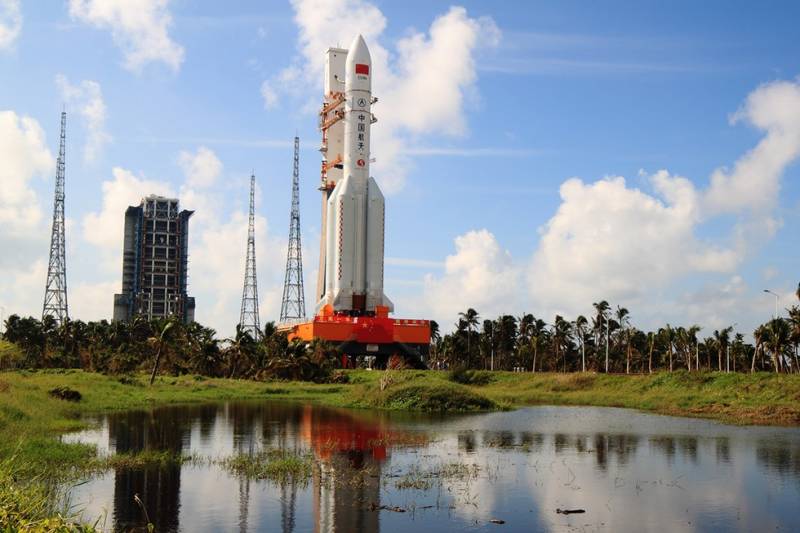
Heavy Changzheng-5 booster before first launch, November 2016. Photo by Chinese Academy of Space Technology / cast.org.cn
October 1 The 2010 of the year launched the Chang'e-2 mission. At this time, the purpose of the spacecraft was to study a given area of the moon, in which it was supposed to make a soft landing of the next lunar module. After all the required actions, the “Chang'e-2” machine was brought to the Lagrange point L2 (Earth-Moon system), and then sent to meet the asteroid (4179) Tautatis. At the end of 2012, images of a celestial body were taken, after which the research apparatus went into deep space.
A survey of the surface of the moon was the first stage of the Chinese lunar program. In the framework of the second stage, it was proposed to deliver the landing module with the rover on board to the natural satellite. In the first days of December, the Xanum-2013 module with the Yuytu lunar rover (Jade hare-Chang'e satellite) was sent to the Moon to the Moon in early December. In the middle of the month, the device made a soft landing in a given area. It is noteworthy that this mission made China the third country in the world that managed to land a research apparatus on the moon. Previously, it was possible only to the Soviet Union and the United States. After landing, the missions of the Chang'e-3 mission were solved only partially due to various technical problems.
Currently, the rocket and space industry in China is preparing for the third phase of the moon exploration program. This time the task of the spacecraft is not only to land on the satellite surface, but also to collect soil samples and then deliver them to Earth. This problem is supposed to be solved during the “Chang'e-5” mission. In addition, to study some issues, we had to develop an auxiliary spacecraft, Chang'e-5Т1.
Before preparing for the launch of the Chang'e-5 mission, it was decided to conduct preliminary studies using the Chang'e-5Т1 equivalent station. Unlike a full-fledged automatic lunar station, the product with the letters “5Т1” had only a service module on the DFH-3A platform and a descent vehicle. The mission of the mission was to fly over the moon along a predetermined trajectory with the subsequent return to Earth and the discharge of the descent vehicle. Such a flight was supposed to show the potential of the Chang'e-5 spacecraft under development, and was also needed to determine the necessary improvements.
23 October 2014 launched the Changzheng-3С launch vehicle from the Xichang space center (Sichuan province) and brought the Chang'e-5Т1 spacecraft to a predetermined trajectory. It took about five days to fly to the Moon and pass through its orbit, after which the device headed back to Earth. October 31 service module dropped the lander, after which he landed in the autonomous region of Inner Mongolia. Over the next few weeks, a series of orbit adjustments were made, after which Chang'e-5Т1 again went to the Moon. At the end of November, the device was put into orbit near the Lagrange point L2, where it was planned to be held for new research.
At the beginning of 2017, the Chinese media published information about the current status of the Chang'e-5 project and the current plans for the space industry. By this time, the Chinese National Space Administration and the enterprises of the rocket and space industry had come quite far in preparing the future mission. In addition, by January, the dates for launching a new spacecraft were determined. So, the first results of the new project should be received already this year.
According to official reports, the launch of the Chang'e-5 mission will take place in November. By the end of the month, the automatic lunar station will go into orbit of the Earth’s satellite and then drop the landing module, whose task will be to conduct surface surveys and sample collection. In the absence of serious technical problems, by the beginning of next year, new regolith portions will be in the hands of Chinese scientists, and in sufficiently large quantities.
According to reports, the automatic station Chang'e-5 will be a fairly large and heavy complex, consisting of several main components. To solve all the tasks assigned, modules with special equipment with a total mass of 8200 kg will be used. In connection with this, the launch of the station will be carried out by the Changzheng-5 heavy-class launch vehicle.
This rocket has a three-stage design and is capable of outputting up to 25 tons of cargo to low earth orbit. Engines of various stages and accelerators use kerosene or liquefied hydrogen with liquid oxygen as an oxidizing agent. In early November last year, the Changzheng-5 rocket made its first flight. The second and most recent launch took place on July 2 this year. Both times the rockets were launched from the Wenchang space center (Hainan Island). The next launch is scheduled for November. The payload of the launch vehicle will be Chang'e-5 station. In the future, a new type of rocket can again be used in the lunar program.
To solve the problem of collecting lunar soil with the subsequent return of samples to Earth, the spacecraft Chang'e-5 should consist of several main components: the orbital, landing, takeoff and return modules. Also previously published information about the possibility of using the planet rover, but later, apparently, such a product was decided to be transferred to the next mission. Thus, the collection of soil samples will be carried out in the immediate vicinity of the planting module. Nevertheless, it should be noted that in this case, the successful completion of the mission will be a real breakthrough for the Chinese astronautics.
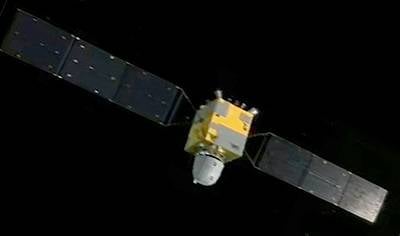
Experimental spacecraft "Chang'-5Т1". Figure Space.skyrocket.de
One of the largest parts of the promising complex will be the orbital module, designed to ensure the delivery of other components to the Moon and back to Earth. It receives a cylindrical body, on the sides of which there are solar batteries laid out in flight. The module is also equipped with a power plant with fuel tanks, control equipment and a casing-housing for connection with the landing module. Inside the enclosure will be a separate return module.
According to published images, the boarding module will be a platform with several light tubular supports and a set of special equipment. It is proposed to equip it with solar batteries, batteries, controls and devices for collecting soil. The roof of the hull of this product will become the launching pad for the take-off module. Thus, the landing module will be able to collect samples and ensure their delivery to the lunar orbit. According to reports, the total weight of the landing module will be 1200 kg.
It is proposed to install a soil collection system using the principle of percussion drilling on the body of the landing module. With the help of a movable support, the auger will be brought to the ground surface, after which it will be able to drill small holes in it. Special cylindrical containers were developed for transporting samples. After loading the sample, the container will be hermetically sealed and placed in the appropriate volume of the take-off module. It is alleged that spacecraft will be able to bring to the Earth 2 kg of regolith.
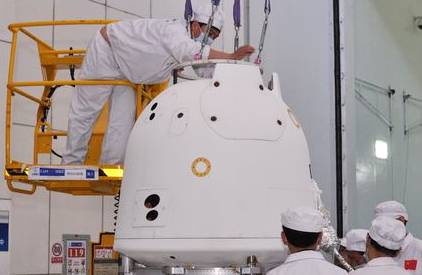
The lander "Chang'e-5T1". Photo of Wikimedia Commons
Part of the research module landing will be able to hold on the spot. For this, it is equipped with some special equipment. On board there are means of analyzing the composition of the soil, soil gas analyzer, mineral spectrometer, etc. To control the operation of the controlled and automated systems, the module receives cameras, landing visors and other devices.
The take-off module, proposed in the project “Chang'e-5”, is a relatively compact and light device with its own power plant and control systems, as well as with a compartment for loading containers with samples. As follows from the published data, containers with a payload can be transferred to other components of the complex. This is necessary to simplify the transportation of soil to the Earth.
The return module of the Chang'e-5 station was designed using the experience of creating and operating the manned ships of the Shenzhou series and therefore must have an appropriate form. This device will receive the equipment for automatic control during independent flight in space and after entering the atmosphere. In addition, the returned module must be equipped with thermal protection. The descent in the atmosphere, after braking to acceptable speeds, will be carried out using a parachute.
From the point of view of the complexity of the program, the mission of Chang'e-5 should differ markedly from its predecessors, which, first of all, is related to the goals set. The launch vehicle will bring the entire complex into a given orbit, after which it will adjust its trajectory and go to the Moon. The orbit of the Earth’s satellite will be undocked, after which the landing module will go to its surface. The orbital module, in turn, will remain on its trajectory and will expect the device with a payload.
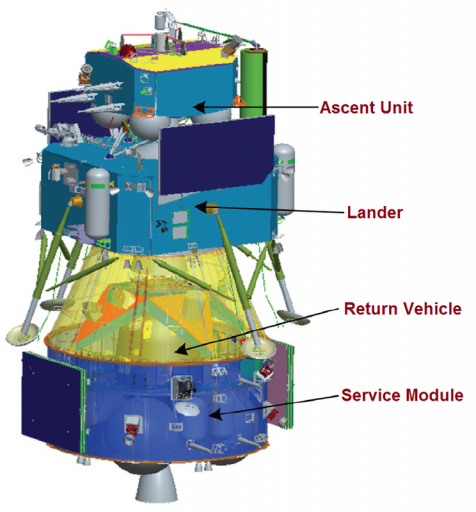
Architecture automatic station "Chang'e-5". Figure Spaceflight101.com
After reaching the surface of the moon, the landing module will have to prepare for further work by deploying solar panels, drilling rigs, etc. Then his task will be to drill holes and collect samples and then load containers into the take-off module. Upon completion of this phase of work, the take-off module, using its own propulsion system, will return to orbit. The landing module will remain on the natural satellite of the Earth.
In near-moon orbit, the take-off module will automatically dock with the orbital one. After that there will be an overload of containers with tests in the returned device. Then the orbital module with the returned apparatus will be able to change the trajectory and go to Earth. At some relatively short distance from the planet, they will be uncoupled. The orbital module will burn in the atmosphere, whereas the returned module will have to land safely in a given area, delivering the samples to scientists.
The launch of the new automatic lunar station is scheduled for November of this year. All the main stages of the mission will take a relatively short time, so that the returned apparatus can deliver samples of lunar soil by the end of the year. The spacecraft "Chang'e-5" will also set a kind of record. Previously, automatic stations brought no more than a few hundred grams of rock from the moon, while the Chinese program means delivering 2 kg immediately.
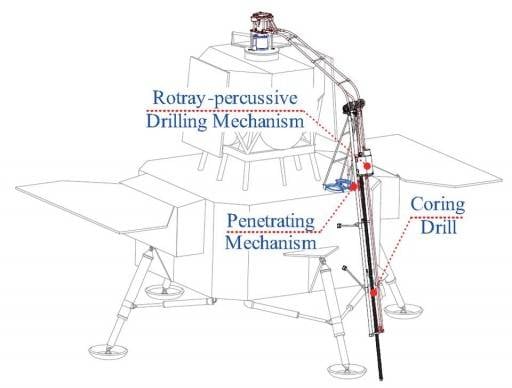
Placement of drilling equipment. Figure Spaceflight101.com
In early June, Chinese scientists named the landing area of the modules of the new station. The landing module will have to descend to the Rumker peak, located in the region of the Ocean of Storms. This area of the lunar surface is of volcanic origin and has a relatively young age. On-site research and the study of the delivered samples will provide new information on the development of erosion processes, on the cooling of the rock and on their interaction.
For several years after the return of the Chang'e-5 module with a cargo of lunar soil on board, Chinese science and industry will analyze the operating experience of the automatic station and draw the necessary conclusions. In the future, the existing developments will be used to create a new similar complex, which, however, will have slightly different tasks. For obvious reasons, the development of the Chang'e-6 station starts no earlier than the end of the November mission.
According to some data, in the next project of the lunar program, China plans to carry out a soft landing of an automatic station, on board of which, in addition to its own stationary equipment, a lunar rover will be present. The launch of such a complex is planned for 2020 for the year, but so far it cannot be excluded that the program schedule will be adjusted in one way or another.
The task of the next stage of the lunar program of the PRC can be the preparation for a manned flight to a natural satellite of the Earth. Probably, first, the Chinese experts will carry out several test missions using automation and remote control, and only after that they will start developing a fully-fledged manned vehicle. For obvious reasons, the timing of such work is still unknown and still can not be predicted. Apparently, the first works in this direction start no earlier than the middle of the next decade. The first manned flight of Chinese astronauts to the moon, respectively, will occur even later.
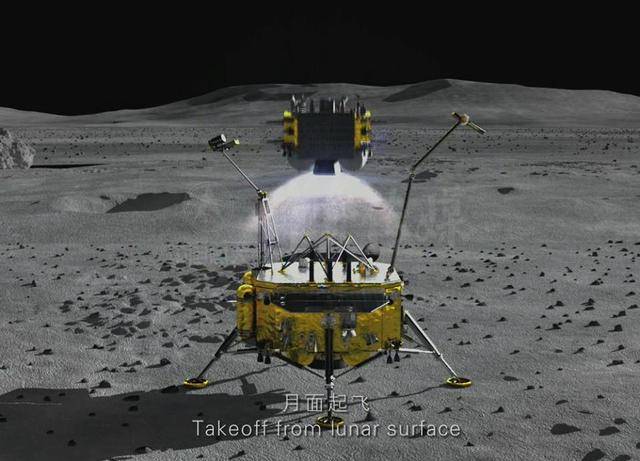
Start independent flight takeoff module. Figure Chinadaily.com.cn
To date, the Chinese lunar program has achieved some success. Several automatic stations for various purposes have already been sent to the moon. It was possible to carry out a soft landing and bring the lunar rover with research equipment to the surface. In just a few months, a station with equipment will be sent to the target for researching the soil, as well as for collecting and sending it to Earth.
Projects of the Chang'e family were created by gradually working out various issues and improving the already finished equipment with its parallel change for current tasks and needs. Thanks to this, in about 7 years, we managed to go a long way from flying over the moon to a soft landing on its surface. It took almost three years to prepare for the mission with the return of the apparatus carrying the samples.
The new mission will start in a few months, and so far China has every reason to count on its successful completion. The return of the apparatus with regolith samples will show the correctness of the ideas underlying the newest project of the automatic lunar station, will help the further development of space technology, and in addition, will provide new information about the natural satellite of the Earth. Whether it will be possible to solve all the tasks in a single project - it will be known in the near future.
On the materials of the sites:
http://cnsa.gov.cn/
http://space.skyrocket.de/
https://space.com/
http://spaceflight101.com/
http://news.xinhuanet.com/
http://chinadaily.com.cn/
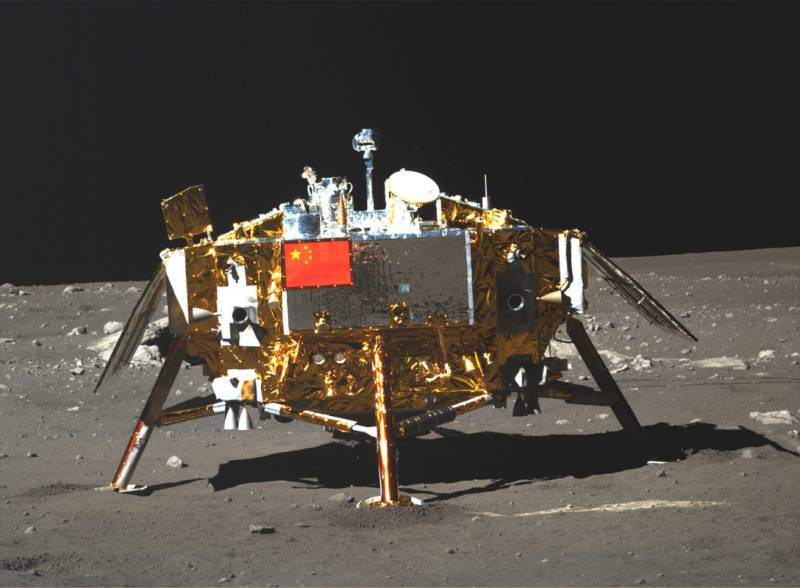
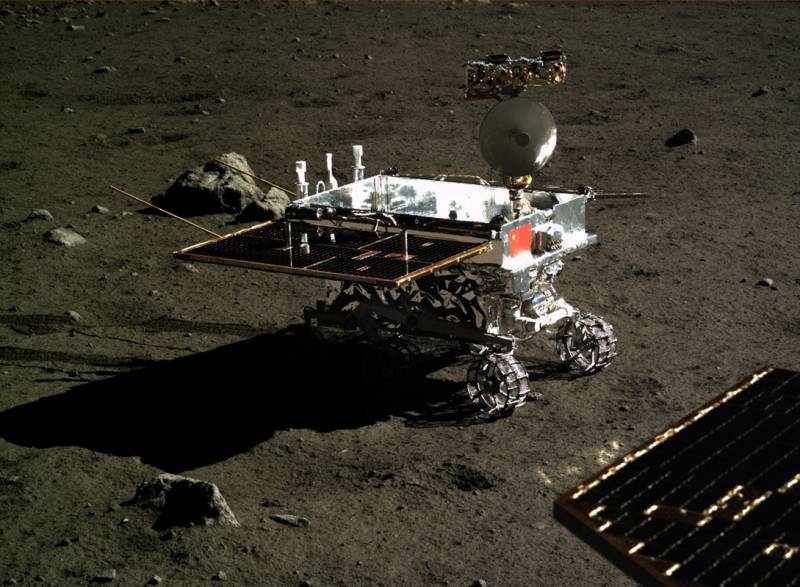
Information